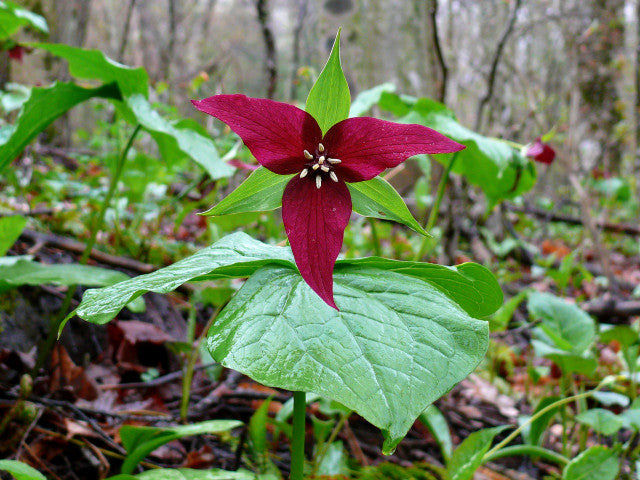
Red Trillium
Red trillium (Trillium erectum), also called wake robin or stinking Benjamin, is a striking woodland wildflower that brings rich, deep color to shady gardens in early to mid-spring. Native to the forests of eastern North America, it is prized for its unique three-petaled flowers, which rise above a whorl of three broad leaves. The blooms range from deep maroon to reddish-purple, sometimes with a hint of brown, and stand out beautifully against the fresh green of the spring understory.
How tall do Red Trillium grow?
Reaching about 12 to 18 inches tall, red trillium emerges from a rhizome each spring, blooming before the forest canopy fully leafs out. The flowers have an earthy, musky scent—nature’s way of attracting early pollinators such as flies and beetles. While the scent may not appeal to human noses, the rich, jewel-toned color and unusual form make it a favorite among native plant gardeners.
Red trillium thrives in moist, humus-rich soil and prefers dappled to full shade. It’s a good choice for woodland gardens, shaded borders, or in natural areas under trees. Once planted, it likes being left alone, as it can take several years to settle in and bloom consistently. In the right spot, it will form small clumps over time, adding more flowers to the spring display each year.
One of the great rewards of growing red trillium is its ability to create a sense of authenticity in a native shade garden. It pairs beautifully with other spring ephemerals like bloodroot, trout lily, Virginia bluebells, and foamflower, creating a tapestry of seasonal color before summer perennials take over. Because it blooms so early, it provides an important nectar source for insects emerging after winter.
Red Trillium are known for their unique spring blooms.
Gardeners choose red trillium for its natural elegance, early-season color, and connection to native woodland habitats. It’s not a fast plant to establish, but its graceful form and rich hues make it worth the patience. When given the right conditions—shade, moisture, and rich soil—it will return year after year, quietly announcing the arrival of spring in the most beautiful way.




